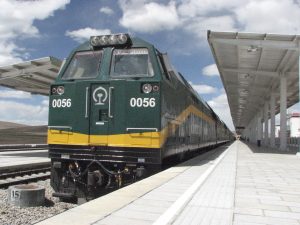By Sudha Ramachandran

China is set to begin construction of a strategic railway line linking Ya’an in Sichuan with Nyingchi in the Tibet Autonomous Region (TAR).
Part of a larger rail project to link Chengdu, the capital of Sichuan, with Lhasa, the capital of Tibet, the Ya’an-Nyingchi rail line constitutes the middle sector of this project. At 1,011-kilometers in length it is the longest of the three sections.
While the Chengdu-Ya’an section of the project, which runs within Sichuan province, is complete and started operations in December 2018, the Lhasa-Nyingchi leg will be ready in 2021. The Ya’an-Nyinchi railway line is expected to be completed by 2030.
Construction of the Ya’an-Nyinchi railway line is a priority for the Chinese government; President Xi Jinping recently called for speeding up completion of the project. He cited the railway line’s importance for implementation of the Chinese Communist Party’s plans for Tibet’s governance and the project’s role in securing China’s national unity and stability in the border areas.
China has been developing overland infrastructure into and inside Tibet. Overland connectivity, especially mass transport via trains, have the potential to enhance Tibet’s economic development via trade and tourism. It also helps Beijing tighten its military and administrative control of the region as it will facilitate rapid deployment of a large number of soldiers there.
In 2006, a railway line linking Golmud in Qinghai to Lhasa was completed. Since Qinghai was already connected with the rest of the China by rail, the Golmud-Lhasa line hooked Tibet on to China’s vast railway network.
The Chengdu-Lhasa rail project will not only improve connectivity between Sichuan and Tibet but also connect these provinces to the rest of China by rail. This is Tibet’s second major railway link with the rest of China.
The Chengdu-Lhasa rail project has other strategic implications too. It runs through Nyingchi, a trading town in Tibet, which lies just north of the Indian state of Arunachal Pradesh, over which China lays claim to as part of South Tibet.
Qian Feng, director of the research department at the National Strategy Institute at Tsinghua University, told Global Times recently that the railway to Nyingchi “will provide great convenience for China’s delivery of strategic materials” to the disputed India-China border if a crisis were to erupt there.
With a rail line running up to Nyingchi, the People’s Liberation Army would be able to swiftly transport large numbers of soldiers and military equipment up to the Indian border at Arunachal Pradesh.
Although the current crisis along the Line of Actual Control (LAC), the de-facto border between India and China, is focused on its western sector, an escalation of tension along the LAC in Arunachal Pradesh cannot be ruled out in the coming months and years. China lays claim to about 90,000 square kilometers of territory in Arunachal Pradesh. It is in this context that China’s construction of infrastructure near the disputed border is worrying India.
China has also built a network of highways across Tibet with links to Nyingchi. A 409-kilometers long expressway built at a cost of $5.8 billion links Lhasa with Nyingchi. Travel time between the two cities has been reduced from eight to five hours.
Dual use airports near the Arunachal border are being upgraded. Located in a “winding valley, one such airport is “one of the most challenging instrument approaches in the world.”
Recent reports also indicate that the Chamdo Bangda Airport, located just 160 kilometers from Arunachal Pradesh is being upgraded. The airport is located at a height of 4,400 meters. Clearly, when it comes to strategic infrastructure in Tibet and especially infrastructure near the disputed border with India, Beijing is not deterred by challenging physical environment.
Although India has been building up its infrastructure along the LAC at Arunachal Pradesh, whether in terms of connectivity or military muscle, it is nowhere near matching that of China.
In November 2019, for instance, the Indian government approved three strategic railway projects, including the 378-kilometers long Bhalukpong-Tenga-Tawang line, the 248-kilometers long North Lakhimpur-Bame-Aalo-Silapathar line and the 227-kilometers long Pasighat-Tezu-Parsuram Kund-Rupai line, aimed at speeding up overland access to the LAC at Arunachal Pradesh.
But the projects are at an incipient stage.
According to the Minister of State for Railways, once the project surveys are completed, it will take another 6-7 years for the Bhalukpong-Tenga-Tawang line to be operational.
Indian infrastructure projects are rarely completed on time. It does seem that it will be at least a decade before Indian railway lines inch up to the LAC in Arunachal Pradesh.
No comments:
Post a Comment